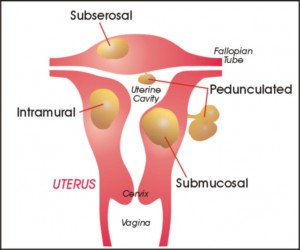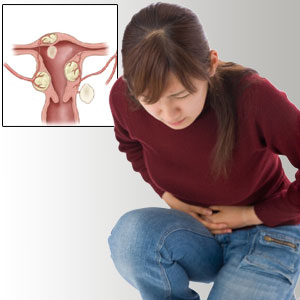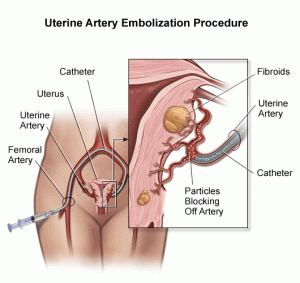
In general, uterine fibroids seldom require treatment. Medical therapy and surgical procedures can shrink or remove fibroids if you have discomfort or troublesome symptoms. Rarely, fibroids can require emergency treatment if they cause sudden, sharp pelvic pain or profuse menstrual bleeding.

- Heavy menstrual bleeding
- Prolonged menstrual periods — seven days or more of menstrual bleeding
- Pelvic pressure or pain
- Frequent urination
- Difficulty emptying your bladder
- Constipation
- Backache or leg pains
Family history is a key factor, since there is often a history of fibroids developing in women of the same family. Race also appears to play a role. Women of African descent are two to three times more likely to develop fibroids than women of other races. Women of African ancestry also develop fibroids at a younger age and may have symptoms from fibroids in their 20s, in contrast to Caucasian women with fibroids, in whom symptoms typically occur during the 30s and 40s. Pregnancy and taking oral contraceptives both decrease the likelihood that fibroids will develop. Fibroids have not been observed in girls who have not reached puberty, but adolescent girls may rarely develop fibroids. Other factors that researchers have associated with an increased risk of developing fibroids include having the first menstrual period (menarche) prior to age 10, consumption of alcohol (particularly beer), uterine infections, and elevated blood pressure (hypertension).

Fibroids Treatment in India – No Surgery, Quick Recovery :- 10 Great Advantages of Uterine Artery Embolization for Fibroids
1. It is performed under Local anaesthesia. Not General anaesthesia.
2. Requires only a tiny nick in the skin (No surgical incision of abdomen).
3. Recovery is shorter than from hysterectomy or open myomectomy.
4. Within 3 days patient can attend the job.
5. Virtually no adhesion formation has been found. But in surgery adhesions are common.
6. All fibroids are treated at once, which is not the case with myomectomy.
7. There has been no observed recurrent growth of treated fibroids in the past 9 years.
8. Uterine fibroid embolization involves virtually no blood loss or risk of blood transfusion.
9. Many women resume light activities in a few days and the majority of women are able to return to normal activities (including exercise) within a week. If the presenting complaint was excess vaginal bleeding, 87-90% of cases experience resolution within 24hours.
10. Emotionally, financially and physically benign procedure -embolization can have an overall advantage over other procedures as the uterus is not removed.
To know more about “Fibroids Treatment” in India please check out this page https://safemedtrip.com/medical-services/laparoscopic-minimally-invasive-surgery-in-india/fibroids-treatment-in-india.html

 Click to WhatsApp
Click to WhatsApp +91-9899993637
+91-9899993637



